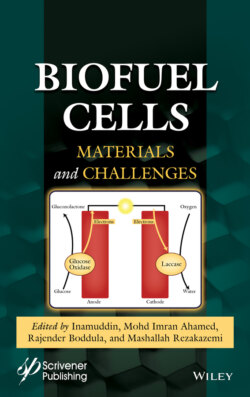Читать книгу Biofuel Cells - Группа авторов - Страница 19
1.4.1 Buckypaper Bioelectrodes for BFCs
ОглавлениеBuckypapers are thin sheets composed of entangled carbon nanotubes, where the thickness can be modulated from tens of nanometers to hundreds of micrometers [99]. Walgama et al. prepared buckypaper with different thickness, finding that 87 μm was the minimal thickness required to develop a mechanically stable electrode to be in contact with aqueous solutions for BFCs [100]. The group of Serge Cosnier has published interesting works related to the use of buckypaper bioelectrodes functionalized with several mediators for glucose biofuel cells. In a recent work, their group used 1,10-phenanthroline-5,6-dione (PLQ) as mediator in a glucose biofuel cell achieving open circuit voltages (OCVs) between 0.67 and 0.74 V, and power densities up to 24 mW cm−3 in a single compartment BFC [101]. Additionally, the same group reported the use of buckypaper functionalized with a pyrene–polynorbornene homopolymer for a flexible lactate BFC [102]. This BFC delivered an OCV of 0.74 V, and a maximum power density of 520 μW cm−2. Güven et al. used buckypaper as bioelectrodes for pyrroloquinoline quinone (PQQ)-dependent glucose dehydrogenase/laccase glucose BFC [103]. The function of buckypaper was to diminish the electrochemical barriers for a direct communication of these enzymes. Thus, a maximum OCV of 0.44 V was achieved, while 49.16 μW cm−2 was the highest achieved power density. Bollella et al. reported a miniaturized glucose BFC based on buckypaper electrodes using PQQ-dependent glucose dehydrogenase and bilirubin oxidase. This BFC achieved an OCV of 0.6 V and a maximum power density close to 10 μW. In addition, the authors implanted the BFC in a living slug obtaining an OCV of 0.31 V, and a power density of 2.4 μW (~4-fold lower to that obtained in ideal conditions) [104]. Hou and Liu reported the use of buckypaper for the incorporation of flavin adenine dinucleotide-glucose dehydrogenase and laccase in a glucose BFC coupled to a supercapacitor based on carbon nanotubes and polyaniline [105]. This combined device achieved 0.8 V and a maximum power density of 608 μW cm−2.
